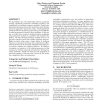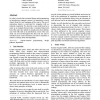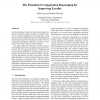884 search results - page 3 / 177 » Control structures in programs and computational complexity |
GECCO
2005
Springer
13 years 11 months ago
2005
Springer
We hypothesize that the relationship between parameter settings, speci
cally parameters controlling mutation, and performance is non-linear in genetic programs. Genetic programmin...
PDP
2002
IEEE
13 years 10 months ago
2002
IEEE
Despite the explosive new interest in Distributed Computing, bringing software — particularly legacy software — to parallel platforms remains a daunting task. The Self Distrib...
ACE
2004
13 years 7 months ago
2004
In order to teach object-oriented design and programming in introductory computer science it is imperative to teach objects from the very beginning of the course. The use of inter...
SC
2004
ACM
13 years 11 months ago
2004
ACM
Improving program locality has become increasingly important on modern computer systems. An effective strategy is to group computations on the same data so that once the data are ...
MFCS
2007
Springer
13 years 12 months ago
2007
Springer
In computability theory, program self-reference is formalized by the not-necessarily-constructive form of Kleene’s Recursion Theorem (krt). In a programming system in which krt h...



